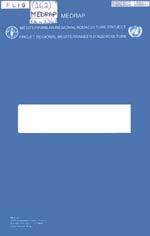

 | PROJET REGIONAL MEDITERRANEEN DE DEVELOPPEMENT DE L'AQUACULTURE |  |
| MEDITERRANEAN REGIONAL AQUACULTURE PROJECT |
 | PRODUCTION IN MARINE HATCHERIES ROVINJ, ZADAR (Yugoslavia), 10–28 Feb 1986 |
Edited by
Brigide LOIX
MEDRAP
Hyperlinks to non-FAO Internet sites do not imply any official endorsement of or responsibility for the opinions, ideas, data or products presented at these locations, or guarantee the validity of the information provided. The sole purpose of links to non-FAO sites is to indicate further information available on related topics.
This electronic document has been scanned using optical character recognition (OCR) software. FAO declines all responsibility for any discrepancies that may exist between the present document and its original printed version.
1.2. Development of the session
1. Fish and shellfish culture in the LIM canal. Present and future pilot farm rearing.
Mr. Z. FILIC, Ms. Hrs. BRENKO. I. IVANCIC
2. Marine aquaculture: Experience of the CENMAR.
3. Marine fish hatcheries: site - production programme - dimensioning.
Mr. L. BERG
1.2. Water supply and water quality
1.3. Building permissions and eventual restrictions
1.4. Proximity of raw materials, labour supply and basic networks
1.5. Proximity of the place of destination for fingerlings
1.7. Eventual existence of economic or social facilities
3.1. Breeding and spawning unit
3.3. Larval rearing and nursery tanks
4. Marine fish hatcheries: Structures - equipment - ecological aspects.
Mr. G. BRUNEL
2. DESIGN OF THE HEARING STRUCTURE
2.1 Definition of the basic units for a hatchery
2.1.1. Definition of the three priniciple cirteria of determination
2.1.2. Secondary design criteria
2.2 The structure of the units for a hatchery
2.2.3. Larval rearing and first fattening units
5. The conception of “Intensive type” fish rearing facilities with partial or total water regeneration.
Mr. J. PETIT
1.2. Conception of the structures -an example-
2.1. Limit design of the hydraulic network system
2.2. Limit design of the water treatment system
Mr. P. BRONZI
7. Production of phyto and zooplankton
Mr. G. FANCIULLI
2. THE PRODUCTION OF PHYTO AND ZOOPLANKTON
2.1. Production cycle of phytoplankton
2.2.1. rearing method employed with Brachionus plicatilis
2.2.2. Method employed for the “mass” production
8. Microorganisms used in aquaculture. The natural zooplankton yield.
Mr. A. PONTICELLI
2. Intensive production of zooplankton
3. The production of zooplankton in large volumes
3.1. Feeble density culture in large volumes
3.2. High density culture in large volumes
4. Extensive production of zooplankton
4.1. Description of a zooplankton collecting device
9. Increased yields of marine fish and shrimp production through application of innovative techniques with Artemia.
Mr. P. SORGELOOS, Ph. LEGER, P. LAVENS, W. TACKAERT
10. International study on Artemia XLII. The effect of the nutritional quality of Artemia on the growth and survival of sea-bass (Dicentrarchus Labrax) larvae in a commercial hatchery.
Mr. V. FRANICEVIC, D. LISAC, J. BUBLE, Ph. LEGER, P. SORGELOOS
11. Reproduction and larval rearing of peneids.
Mr. F. LUMARE
12. The production of shrimp post-larvae : the present situation of hatchery Penaeus japonicus
Mr. G. LE MOULAC. C. DE LA POMELIE
13. Larving rearing of bivalve molluscs.
Mr. G. ROMAN
14. MULLET: Artificial propagation.
Mr. C. NASH, R. M. KONINGSBERGER
Mr. C. AGIUS
9.3. Intensive selective grading
16. Larval rearing. weaning and firt fattening of sole and turbot.
Mr. B. MENU
17. Fry production techniques of red-sea-bream, Pagrus major, in Japan.
Mr. C. KITAJIMA
2. LARVAL AND JUVENILE REARING
2.3. Juvenile rearing in net cages
2.6.1. Sequential change of larval and juvenile feed
2.6.2. Daily feed consumption and feed supply
2.6.3. Dietary value of live organisms
3.2. Culture of Tigriopus japonicus
18. Four marine spawners in Europe hatcheries.
Ms. N. DEVAUCHELLE
19. Larval shrimp feeding: crustacean tissue suspension: a practical alternative for shrimp culture
Mr. A. G. J. TACON
3.1 Fry production in hatcheries : programme
3.2. List and addresses of the participants
3.3. List and addresses of the lecturers